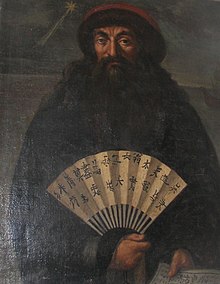|
Prospero Intorcetta
Prospero Intorcetta (1625–1696), known to the Chinese as Yin Duoze, was an Italian Jesuit missionary to the Qing Empire. He was the first to translate the works of Confucius in Europe. LifeProspero Intorcetta was born in Piazza Armerina, Sicily, on August 28, 1625. Traveling with the Flemish Jesuit Philippe Couplet, he reached China in 1659. There, he mostly worked in the Jiangnan region around the lower Yangtze River.[1] He died on October 3, 1696, in Hangzhou.[citation needed] Works  Intorcetta studied Chinese philosophy. In 1662, he published the study of the Four Books of Confucianism in a Latin work entitled The Meaning of Chinese Wisdom.[2] In 1667, he published the Politico-Moral Knowledge of the Chinese (Sinarum Scientia Politico-moralis). In 1687, under Philippe Couplet's guidance, he worked with Christian Wolfgang Herdtrich and François de Rougemont to compile an influential Latin overview of Chinese history and translation of some of the Confucian classics under the title Confucius, Philosopher of the Chinese (Confucius Sinarum Philosophus). See alsoReferencesCitations
Bibliography
External links
|
||||||||||||||||||
